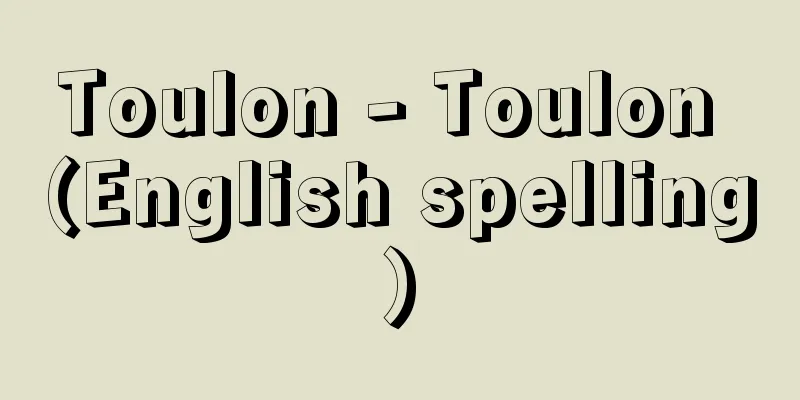Toulon - Toulon (English spelling)

|
It is a port city and the capital of the department of Bar in southeastern France. It is located about 50 km southeast of Marseille and faces the Mediterranean Sea. It has a population of 160,639 (1999). It has a natural harbor facing Toulon Bay, surrounded by the Seve Peninsula in the south and the fortress of Mount Faron in the north. The port is the largest military port in France and has a large naval arsenal. As a result, the industry has developed in naval-related fields such as shipbuilding and chemicals, and the development of commerce is also largely due to the existence of the navy. It is also home to food industries such as wine and olives, which are specialties of the Mediterranean region. The commercial port is on the east side, and these food products are exported and oil, lumber, etc. are imported. It is also located at the western end of the Cote d'Azur, and has a warm climate with average temperatures of 8.6°C in January and 22.6°C in July, and an annual precipitation of 706 mm. It is also a seaside resort with good transportation access. [Nobuyoshi Aoki] historyIn ancient times, it was a Roman colony and was known as a producer of crimson dye. In the Middle Ages, it was often invaded by Muslims. It became the territory of the Count of Anjou in the mid-13th century, and was just a village in Provence at that time, but at the end of the 15th century, Provence was annexed to the royal domain, and Toulon became the naval base of the Bourbon dynasty, and since then, it has flourished as a military port city. Napoleon set out from here for his Egyptian campaign. The colonial rule of Algeria during the July Monarchy (1830-48) promoted the development of Toulon and further strengthened its character as a military port city. During World War II, most of the French battleships were gathered here, but when the German army tried to seize them, the French side drilled holes in the bottoms of the ships and sank them to prevent them falling into enemy hands (November 1942). [Honike Ryu] Source: Shogakukan Encyclopedia Nipponica About Encyclopedia Nipponica Information | Legend |
|
フランス南東部、バール県の県都で、港湾都市。マルセイユの南東約50キロメートルに位置し、地中海に面する。人口16万0639(1999)。北部には要塞(ようさい)のあるファロン山を控え、南部はセベ半島に囲まれたトゥーロン湾に臨む天然の良港を有する。港はフランス第一の軍港で、大規模な海軍工廠(こうしょう)がある。そのため産業は造船業、化学工業など海軍関連の分野が発達し、商業の発展も海軍の存在に負うところが大きい。地中海地方特産のワインやオリーブなどの食料品工業も立地する。商港は東側にあり、これら食料品を輸出して、石油、木材などを輸入している。また、コート・ダジュールの西端に位置して、平均気温は1月8.6℃、7月22.6℃、年降水量706ミリメートルと気候温暖であり、交通の便もよいところから海浜保養地ともなっている。 [青木伸好] 歴史古代にはローマの植民地で、真紅色染料の産地として知られていた。中世にはしばしばイスラム教徒の侵略を受けた。13世紀なかばからアンジュー伯の領地となり、そのころはプロバンスの一村落にすぎなかったが、15世紀末にプロバンスが王領に併合され、トゥーロンはブルボン王朝の海軍基地となり、それ以来、この地は軍港都市として栄えるようになった。ナポレオンはここからエジプト遠征に向かった。7月王政期(1830~48)に進められたアルジェリアの植民地支配は、トゥーロンの発展を促進するとともに、軍港都市としての性格をいっそう強めるようになった。第二次世界大戦中、フランスの戦艦の大部分がここに集められていたが、ドイツ軍がこれを奪おうとすると、フランス側は船底に穴をあけて沈め、敵の手に渡るのを防いだ(1942年11月)。 [本池 立] 出典 小学館 日本大百科全書(ニッポニカ)日本大百科全書(ニッポニカ)について 情報 | 凡例 |
Recommend
Bu-ci - Bokuji (English spelling)
Also known as oracle bone inscriptions. In the Sha...
Okinawa Development Finance Corporation
A government financial institution limited to Okin...
Winkler, H. (botanist) - Winkler
…It is named after the Greek mythological monster...
Mount Takago
This mountain is located in the southwest of Chib...
City Law - Toshiho (English spelling) Stadtrecht; Weichbildrecht
The laws specific to medieval European cities form...
Horseback riding - fangs
〘 noun 〙 To ride a horse. Also, the person who rid...
Balcony - Balcony (English spelling)
A roofless platform with a railing that is extend...
Mansuy, H.
…It is located on a low hill overlooking the allu...
Arkansas Stone - Arkansas Stone
...The name comes from the fact that a few drops ...
Gast, L. (English spelling) GastL
...The former is a fairy tale, the latter a famil...
Boudicca
...After Caesar's invasion of Britain, contac...
Kimul - Kimul
…The capital is Cardiff. The name of the city com...
Pinocytosis
…Endocytosis is a general term for the action of ...
Sa'd (English spelling) Sad
...In other words, Algeria was ruled by a militar...
Sudan
◎Official name: Republic of the Sudan (al-Jumhuriy...









